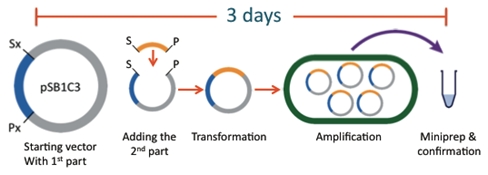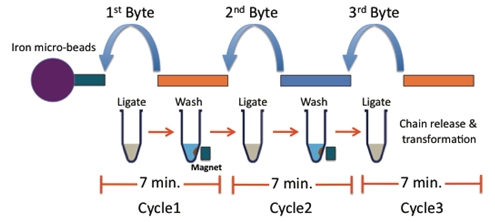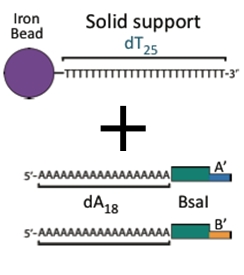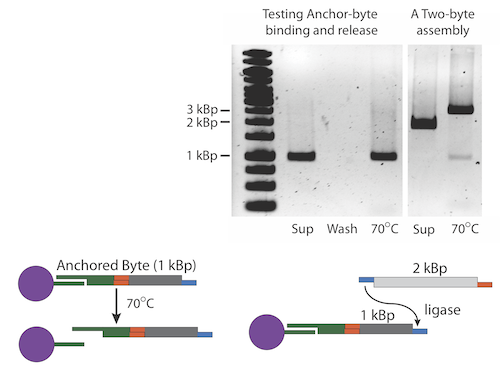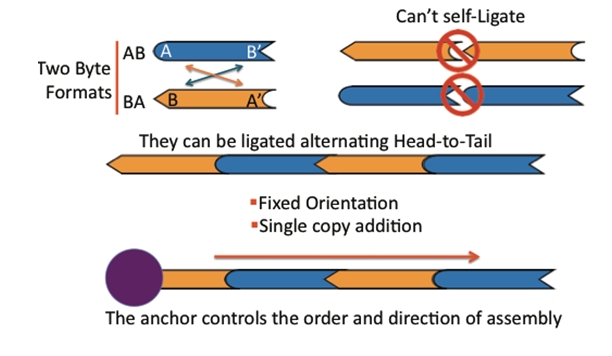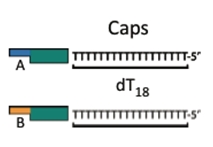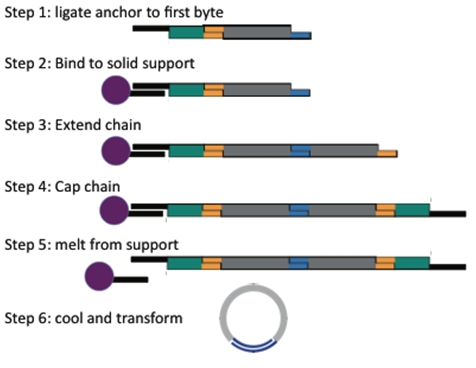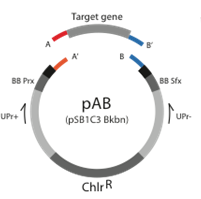Team:Alberta/biobyte2
From 2010.igem.org
Overview
BioBytes 2.0 is the heart of the GENOMIKON kit. BioBytes 2.0 is a method of creating novel plasmids through the sequential addition of functional units of DNA. It is designed to be used in a high school setting but has potential to be used in professional settings as well. The assembly method we have created has some conceptual similarities to the original BioBytes Assembly System developed from the 2009 Alberta iGEM project. However, there are some striking differences between the two systems.
Traditional Methods
The current assembly standard is the BioBrick method. While the registry of parts and the assembly standard has allowed for effective construction of plasmids in a laboratory setting, it has numerous limitations prohibiting its use in high schools. For example, common laboratory protocols such as transformation, ligation, and restriction digestion require materials and equipment not available to high schools. Not only does this require expensive reagents and equipment, it also takes days to weeks to assemble a complicated construct. An experiment of such length far surpasses the average high school student’s attention span and the time a curriculum can spend on a particular subject.
Comparison
The BioBytes Assembly System 2.0 has provided a solution to these issues. The GENOMIKON kit is fast allowing for assembly of a novel plasmid in an afternoon rather than over the course of several days. The kit is completely self-contained, requiring no other equipment or reagents that does not come with the kit. This eliminates the need for the expensive equipment and reagents common place in a University laboratory setting. The addition of one part to a construct takes under 10 minutes. So creating a plasmid of your desired specifications can happen in an afternoon, rather than the 3 or more days to create a plasmid through the traditional BioBrick methods.
Components of the System
The Assembly Method 2.0 is composed of three main components. An anchor byte attached to an iron micro bead is the beginning of a construct. Because of the magnetic nature of these beads, they can be positioned by using a simple magnet. The BioBytes are added to the anchor-byte one at a time in sequence. This is possible due to the alternating overhang structure of the BioBytes. Finally, a cap is added allowing for circularization of the construct. The construct is now ready to transform
Anchor Byte
The Anchor-byte begins the process of assembly. It is composed of:
- a poly-A tail
- a BsaI recognition site
- an A or B overhang
Iron micro beads purchased from New England Biolabs have covalently attached poly-T tails. The bead allows us to manipulate the DNA with magnets making washing and subsequent attachments easier.
We have designed an anchor byte which begins the process of assembly. The anchor-byte is comprised of an Anchor piece ligated to the first byte of the assembly. Construction begins by ligating a selectable marker to the anchor. This first step allows for complete constructs to be selected for. As well, the incorporation of a BsaI cut site into the Anchor, before the first byte, gives versatility to the construct because the first byte and the rest of the construct can be removed from the anchor, and used as a Byte in and of itself.
Once the selectable marker is ligated to the first byte, we anneal the anchor-byte to the poly-T tails on the iron micro bead. We have created anchors with both varieties of ends so that assemblies can begin with any type of byte. The results of one of our experiments is shown here. Note that the interaction between the anchor and the bead is non-covalent. The anchor along with the construct can be separated from the bead with heat. The gel shows the process of anchoring a construct. A anchor-byte construct of 1kb is allowed to anneal to the magnetic beads. This is done in excess, and the supernatant is shown in the first lane. A subsequent wash step showed the absence of DNA, indicating that DNA construct is stably bound. The construct can be melted from the scaffold at 70 degrees Celsius. The melted construct can be seen in the last lane.
This schematic shows the alternating addition of bytes starting from the anchor. Parts are added and ligated in an sequential fashion. Cycle time for each step was about 7 minutes. This is much faster than the Biobrick method. In on of our assemblies, we were able to create an octamer, with a total size of 12 kb. As you can see, there are some minor incomplete products.
If you recall, we have incorporated a BsaI cut site into the anchor. This allows for constructs to be created in parallel and then utilized as large Bytes in the assembly in the same way.
BioBytes v.2
This year's BioByte design has a number of unique features. Each Byte has 4 base 5' overhangs on each side. These overhangs have be engineered to serve a number of purposes. The overhangs allow for ordered and sequential addition of parts to growing assemblies.
The addition of each byte to a growing assembly takes about 7 minutes.
Cap
The cap is analogous to the anchor. The cap finishes the construct, where the anchor starts a construct. The cap is comprised of a poly-T tail, complimentary to the poly-A tail of the anchor piece. The cap also contains a BsaI cut site which allows it's removal from the construct. The cap also comes in both applicable flavors with an A or B overhang.
When finishing a construct, the cap is added and ligated to the growing construct, in the same manner as another byte. The completed construct is the heated, to melt the anchor piece from the iron micro bead. The solution is removed from the beads and allowed to cool. The cap and anchor then have opportunity to anneal to each other. The construct is now ready for transformation without ligation.
The Assembly Process
Starting with an anchor, add the first piece and ligate.
Then anneal the anchor-byte construct to the iron micro beads by incubating at room temperature for 30 minutes, mixing every 5 minutes. Now you can wash away the excess of the anchor-byte. This is done by putting the tube in the magnetic rack, allowing the magnet to pull all the beads with your anchor-byte attached to one side, and removing the supernatant.
Before another part is added, wash the beads twice with Wash Buffer. This is done by adding wash buffer, mixing the iron micro beads into the solution, pulling the beads to the side and pulling out the supernatant. Add the next piece in an equimolar amount to the anchor-byte and ligate for 5 minutes with Quick Ligation TM Kit purchased from NEB. Ensure that the beads have been distributed into the solution during the ligation. Again remove the supernatant and wash twice before adding the next part.
Then when you have added all the parts you want, add the cap in exactly the same way as any other byte except add it in 20 times molar excess. After you add the cap, remove the supernatant, and wash twice again with wash buffer. Wash the beads a third time with room temperature elution buffer.
Now just heat to release the construct, add hot (75oC) elution buffer and incubate the solution at 75oC for 10 minutes. Move the beads to the side, and remove the supernatant to a second tube and put it on ice. Your construct should be in the supernatant. The cold allows the cap and the anchor to anneal and the plasmid is circularized and ready for transformation.
Easy!
Using this process we were able to assemble eight pieces in an afternoon!
Byte Construction
BioBytes Vs BioBytes 2.0
The "BioBytes Version 2.0" construction method has been shown to create (insert actual data here) plasmids from up to 8 separate parts in
an afternoon's work. This is a vast improvement.
 "
"

